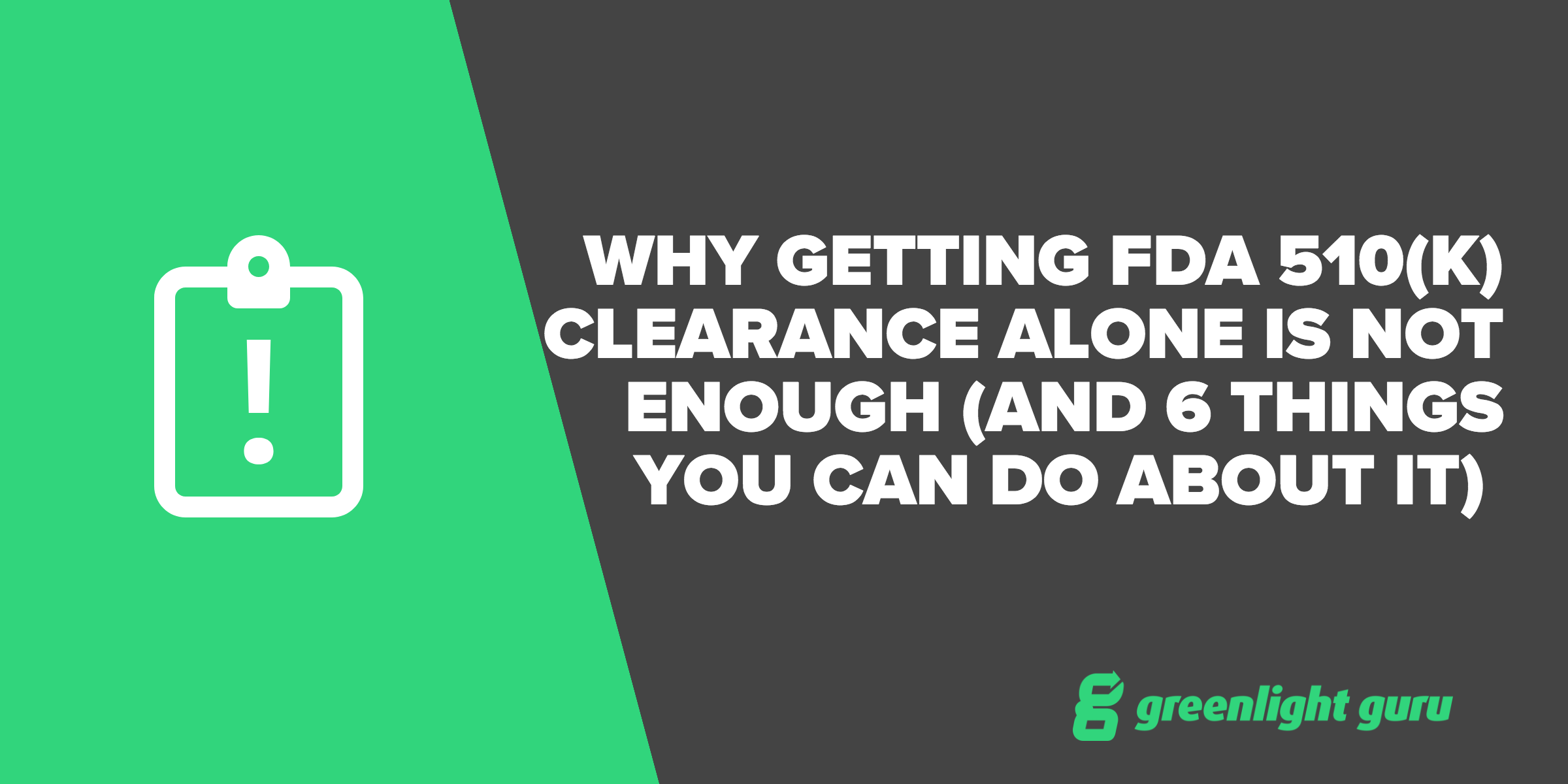Why Getting FDA 510(k) Clearance Alone is Not Enough (And 6 Things You Can Do About It)

Getting FDA 510(k) market clearance is a significant, meaningful milestone and achievement for any medical device company.Preparing the contents of the 510(k) submission and going through the review process with FDA is far from trivial and easy.
Getting a device ready for 510(k) submission is usually time-consuming, costly, and full of challenges. Going through a review process with FDA is likely to take longer than expected and result in additional expenses to address unanticipated questions.
But getting that letter from FDA stating you have successfully received market clearance can make it all worth it!
Free eBook Download: Get a PDF version of this article by clicking here.
An Alarming Trend with 510(k) Submissions
During the past several months, I have talked to and worked with dozens and dozens of medical device companies in pursuit of or receipt of a 510(k) clearance letter.
There is an alarming trend happening in the medical device industry right now. And the trend is this.
Many medical device companies are compiling and submitting 510(k)s to FDA for review without establishing a QMS, without documenting Design Controls, and without document Risk Management.
This is alarming because the FDA’s quality system regulations are very clear.
Design Controls are required during the product development process. FDA also expects medical device companies to establish ISO 14971 compliant Risk Management processes.
And a 510(k) submission is an output of the product development process. Meaning you should have documented Design Controls and Risk Management leading up to submitting 510(k) to FDA.
Medical device companies are required to establish and follow a QMS per FDA regulations, as well.
Sadly, medical device companies neglecting Design Controls, Risk Management, and QMS in their quest for 510(k) market clearance may not realize the perils of their mistakes for a couple years.
FDA does not officially check that the company has established documentation and records aligning with regulations during a 510(k) submission review. FDA’s objective is to review the contents of the 510(k) to determine device safety and substantial equivalence.
But one day, FDA will come knocking on your door for an FDA inspection. Every company with a class II and higher medical device is subject to inspection by FDA every 2 years.
It’s during this inspection when FDA will discover lack of QMS, Design Controls, and Risk Management.
And the company will have no choice but to accept the consequences, which could have major, negative results.
Avoid the Mistakes - Lessons from a True Story
Yes, you are correct. The expected contents of a 510(k) submission are pretty well identified by FDA. Yes, there are all kinds of experts and consultants who are ready to help you put together a 510(k) and manage that FDA review process to get you a clearance letter.
Chances are, your funding milestones are contingent on either getting a 510(k) submitted to and/or cleared by FDA. If this is the case for your company, you might be smiling ear to ear as you work with the 510(k) consultant to prepare your submission.
Did you know you might be setting your company up for a huge regulatory compliance nightmare in the process?
If you are singularly focused on getting a FDA 510(k) submission ready and sent off for review, you are almost guaranteeing your company will have future regulatory compliance issues down the road.
Let me explain through a true, short story. The events are real. The names have been changed.
Acme Medical Device Company hired consultant Joe Smith to help them prepare their FDA 510(k) submission. Mr. Smith had a proven track record. Last year, he successfully prepared 25 510(k) submissions, guiding each and every one through FDA review and clearance.
Acme’s investors were keen to get 510(k) market clearance. Doing so meant the product could be rolled out for a soft launch to several key opinion leaders in order to do some further clinical investigation and first in man clinical studies.
All resources were dedicated to preparing and getting the 510(k) through. The success of the company depended on it.
And Joe Smith was good--really good. He was able to navigate all FDA inquiries and ultimately get the 510(k) market clearance in about 100 days. He did the job he was hired to do. Acme paid him handsomely for his efforts.
It was worth it to get that FDA letter.
Fast forward a couple years later.
FDA called Acme Medical Device Company to schedule their baseline FDA inspection. Acme wasn’t worried. They had that magic clearance letter from FDA. Joe Smith was the man for them!
The day of the FDA inspection arrived. And it was brutal. FDA remained on site for 8 days. And in the process, FDA identified 14 483 observations. The list included the following:
-
Lack of Design Controls process defined
-
No Design History File (DHF)
-
Quality System does not establish complaint procedures
-
Quality System does not define CAPA process
Acme Medical Device Company exited the FDA inspection a little confused.
Did Joe Smith lead them astray?
What did they fail to address during the design & development of their medical device?
Why did they fail to implement a QMS?
The major mistake Acme made was this: They assumed that all they needed to focus on was get FDA 510(k) clearance.
They did not document Design Controls.
They did not document Risk Management.
They did not establish a Quality Management System.
They did not keep documents and records under control.
Joe Smith seemed like an ally because he helped Acme get 510(k) clearance.
But did Mr. Smith provide Acme a huge disservice by not checking Design Controls, Risk Management, and QMS?
In a word, yes.
Or maybe not.
Mr. Smith was hired to compile a 510(k) submission. He was not hired for anything else.
And he did nothing else and only focused on the 510(k).
Acme did not focus on Design Controls, Risk Management, or QMS.
I wish I could say the story of Acme Medical Device Company was unique.
Sadly, I cannot.
There are hundreds of med device companies making these same mistakes every single year.
Hopefully you are not one of them.
And each time, I take the opportunity to try and educate each of these companies of the major mistakes they are making. Sometimes they listen. Most of the time, they rely on the guidance and direction of their 510(k) consultant.
They feel as though the FDA Quality System Regulations (as defined in FDA 21 CFR part 820) somehow either don’t apply to their company or that since they have 510(k) clearance, this is all they need.
They seem willing to roll the dice and gamble the fate of their company on ignoring the regulations.
Free eBook Download: Get a PDF version of this article by clicking here.
6 Things You Can Do
My advice to you is simple: Don’t be like Acme Medical Device Company and ignore QMS, Design Controls, and Risk Management.
In order to do so, here are 6 tips you need to follow:
-
Define your Design Controls process. Follow 21 CFR part 820.30 (and check out “The Ultimate Guide to Design Controls”)
-
Document Design Controls activities leading up to your 510(k) submission. Realize that Design Controls are necessary and essential to a 510(k) (regardless of what your 510(k) consultant might say).
-
You can’t design, develop, or manufacture a medical device without paying attention to Risk Management. And you better align with ISO 14971.
-
Establish your Quality Management System from the beginning. Bootstrap during product development and continue to build your QMS as you prepare for product launch.
-
Be ready for an FDA inspection. It will happen.
-
Take action! You must understand how and what to do with QMS + Design Controls + Risk Management leading up to and after 510(k).
Jon Speer is a medical device expert with over 20 years of industry experience. Jon knows the best medical device companies in the world use quality as an accelerator. That's why he created Greenlight Guru to help companies move beyond compliance to True Quality.









